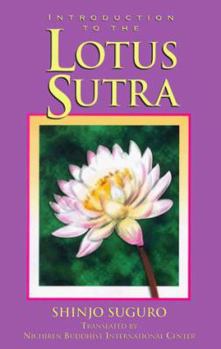Introduction to the Lotus Sutra
Select Format
Select Condition 
Book Overview
To many Buddhists, the Lotus Sutra is one of the most important, if not the most important, sutras in the Buddhist canon. To the beginning student of Buddhism, however, the Lotus Sutra often presents... This description may be from another edition of this product.
Format:Paperback
Language:English
ISBN:0875730787
ISBN13:9780875730783
Release Date:January 1998
Publisher:Jain Publishing Company
Length:230 Pages
Weight:0.75 lbs.
Dimensions:0.5" x 5.6" x 8.5"
Customer Reviews
2 ratings
Awesome!! NAM-MYOHO-RENGE-KYO.
Published by Thriftbooks.com User , 18 years ago
Great introduction to the poetic teaching of the Lotus Sutra. I've been a devout Nichiren Buddhist as a member of SGI for 8 years now and can not imagine any other way. In the SGI, the practice of True Buddhism is open to all, no exceptions!! The SGI continues the advancement of world peace through dialogue with all human-beings of all religions, and supports the fulfillent of each member's dreams through the practice of the True Buddhism of Nichiren Daishonin. The best interpretations of the 2nd and 16th chapters of The Lotus Sutra are found in the lectures of Daisaku Ikeda. Nam-myoho-renge-kyo, nam-myoho-renge-kyo. www.sgi-usa.org
Cliff Notes for the Lotus Sutra
Published by Thriftbooks.com User , 22 years ago
Anyone looking for a good chapter-by-chapter summary and commentary on the Lotus Sutra should look no further than this book. Rev. Suguro (he is a priest of the Nichiren Shu) also covers the two sutras that open and close the Lotus Sutra, the Sutra of Innumerable Meanings and the Sutra of Meditation on Bodhisattva Samantabhadra. He also highlights the seven famous parables of the Lotus Sutra, including the Parable of the Burning House (which is well known from Hui-Neng's discussion of it in the Platform Scripture) and the Parable of the Prodigal Son. Rev. Suguro also highlights those passages which are of particular importance to Nichiren Buddhism and also discusses the T'ien-t'ai system of analyzing the sutra according to the diffent functions of its various sections. There is also a brief discussion of Nichiren's reading of the Lotus Sutra in an appendix. I hasten to add, however, that this book was not written from a sectarian point of view. Rather, it was written to open up the Lotus Sutra for all Buddhists and non-Buddhists who wish to get a better understanding of what this most famous of Mahayana sutras is about. A valuable introductory work like this is especially important for the Lotus Sutra, since even famed Zen Masters like Hakuin had difficulty appreciating the depths of the Lotus Sutra simply by reading it on their own without a guide and/or a few satoris under their belt. Many Zen practitioners should also know that Dogen also frequently quoted from the Lotus Sutra in his monumental work the Shobogenzo. So I would recommend this book to anyone who might be wondering why Hui-Neng, Hakuin, and Dogen found the Lotus Sutra so fascinating. For Nichiren Buddhists, it should go without saying that a guide to the Lotus Sutra would be invaluable. The only drawback to this book is that it sometimes takes for granted that the reader has already had a basic eduction in foundational Buddhism and Mahayana Buddhism. So this book is not a good introduction to Buddhist itself - but it does give a cursory explanation of basic Buddhist and basic Mahayana concepts as they appear within the Lotus Sutra. One last note, this book uses passages from the English translation of the Lotus Sutra by Rev. Senchu Murano. This translation is available from the Nichiren Shu and is highly regarded as a very authoritative and readily understandable translation.Namu Myoho Renge Kyo, Rev. Ryuei McCormick




